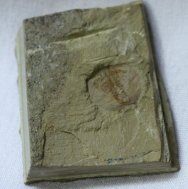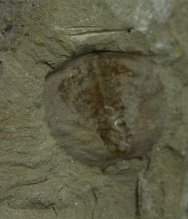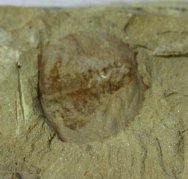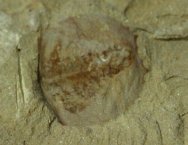 Description:
The exact taxonomic status of this arthropod is in dispute. It
has been termed a “trilobitomorph” by some researchers,
showing their beliefs in its close affinity with the trilobites.
While the Trilobitoorpha was listed in the Treatise, most now
consider that this subphylum is invalid, a catchall much like
some of the dustbin terms used by Walcott for a number of the
Burgess Shale fauna. Whittington termed it a “soft-bodied
trilobite”’ but that belief is not supported at present.
Their similarity in appearance to Description:
The exact taxonomic status of this arthropod is in dispute. It
has been termed a “trilobitomorph” by some researchers,
showing their beliefs in its close affinity with the trilobites.
While the Trilobitoorpha was listed in the Treatise, most now
consider that this subphylum is invalid, a catchall much like
some of the dustbin terms used by Walcott for a number of the
Burgess Shale fauna. Whittington termed it a “soft-bodied
trilobite”’ but that belief is not supported at present.
Their similarity in appearance to 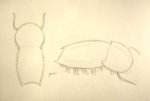 the Agnostida is purely a
result of convergence. Two large groupings of the Paleozoic arthropods
are currently in favor: the Crustaceomorpha (which includes Waptia)
and the Arachnomorpha, dominated by the trilobites. The Naraoiidae
are arachnomorphs and include Misszhouia and Naraoia, with this
one, Naraoia spinosa, named for the spinose cuticle so well preserved
here. The species is one found in several locations within Yunnan
Province. the Agnostida is purely a
result of convergence. Two large groupings of the Paleozoic arthropods
are currently in favor: the Crustaceomorpha (which includes Waptia)
and the Arachnomorpha, dominated by the trilobites. The Naraoiidae
are arachnomorphs and include Misszhouia and Naraoia, with this
one, Naraoia spinosa, named for the spinose cuticle so well preserved
here. The species is one found in several locations within Yunnan
Province.
The
diversity of Chengjiang Biota soft-tissue fossils is astonishing:
algae, medusiforms, sponges, priapulids, annelid-like worms,
echinoderms, arthropods (including trilobites), hemichordates,
chordates, and the first agnathan fish make up just a small
fraction of the total. Numerous problematic forms are known as
well, some
of which may have represented failed attempts at diversity
that did not persist to the present day.
This
one shows many of the
classic features of the taxon, even the diverticulae (digestive
glands) and the central gut are evidence, as is the soft
cuticle that betrays the outline of the body. Even if it is not
a true
trilobite, it is sure to be a coveted addition to any collection.
What makes this one even more unusual is the fact that some
of the internal organs have been preserved in three dimensions,
rather than the typical flat specimens most often seen. The
cephalon
is still covered by matrix which could be removed to afford
an even more impressive specimen. With the recent designation
of
the Chengiang sites as UNESCO World Heritage locations only
examples such as this collected many years ago will be available.
Also
see: Chengjiang
Biota Fauna List Chengjiang
Fossils
|


